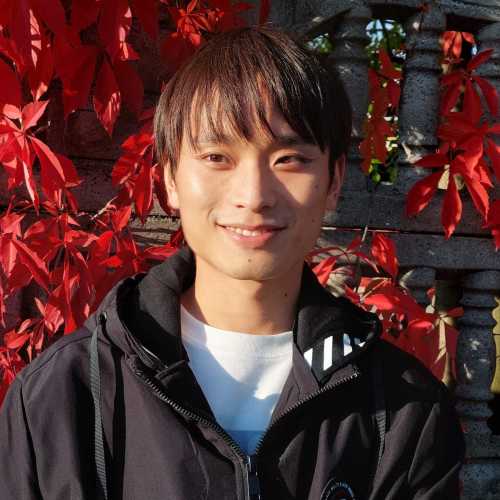Table Of Contents
- Why Neighborhoods Matter in a City Like Osaka
- Umeda: Modern Infrastructure Meets Lofty Views
- Namba & Shinsaibashi: Nightlife, Street Food & Shopping
- Osaka Bay Area: Big Attractions & Wide-Open Stays
- Tennoji & Abeno: Honest Osaka With a View
- Hidden Neighborhoods Worth Your Time
- Choosing Based on Your Travel Style
- Transportation: The Hidden Factor in Neighborhood Choice
- Seasonal Considerations for Neighborhood Selection
- Essential Local Attractions Beyond the Famous Sites
- Making Your Final Decision
- Beyond the Hotel: Living Like a Local
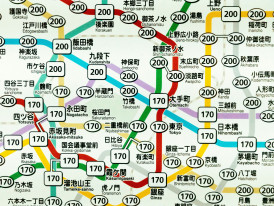
A subway map showing Osaka's neighborhood spread Photo by Jackie Alexander on Unsplash
I've lived in Osaka for fifteen years, and I still get asked the same question by visitors: "Which neighborhood should I stay in?" The honest answer is that it depends on what kind of trip you're planning, but more importantly, it depends on understanding how Japan's third largest city actually works. As someone who's explored every corner of Osaka city, from the bustling downtown Osaka districts to quiet residential areas, I know that the right choice makes the difference between a good trip and an incredible one.
Osaka isn't like Tokyo, where districts have clear personalities that tourists can easily decode. Here, neighborhoods blend into each other, and the best experiences often happen in the spaces between the famous spots. I've watched countless visitors book hotel rooms based on generic travel advice, only to spend their days riding trains to places they could have walked to if they'd chosen differently.
This guide breaks down where to stay in Osaka based on real considerations: subway access, food quality, noise levels, and what you'll actually encounter when you step out your hotel door. I'll tell you which areas live up to their reputation and which ones are better experienced as day trips rather than home bases. Whether you're seeking luxury hotels with modern rooms and a fitness center, or you prefer more affordable prices in authentic residential areas, understanding each neighborhood's character helps you make the right choice for your hotel stay.

Overhead shot of Osaka's cityscape with distinct districts visible
Why Neighborhoods Matter in a City Like Osaka
Understanding Osaka's layout saves you time and money. The city sprawls in ways that make some combinations of activities efficient and others frustrating. I've seen travelers waste entire mornings on trains because they didn't realize their hotel in the Osaka Bay area was a 45-minute ride from the street food stalls they wanted to try in downtown Osaka.
The subway system connects everything, but frequency and transfer complexity vary dramatically. Staying near Umeda Station, Osaka's largest train station, gives you access to six different lines and puts you within a short walk of major shopping and business district amenities. Meanwhile, some budget hotels near the bay require two transfers to reach Namba Station. These details matter when you're carrying shopping bags or trying to catch the last train after exploring nightlife hotspots.
Osaka's neighborhoods also have distinct rhythms. The business district goes quiet after 8 PM, while entertainment areas like the Minami area stay loud until dawn. Tourist zones maintain a polished veneer, but residential areas reveal where locals actually eat and shop. Some areas offer nightlife hotspots and constant energy, while others provide a quieter atmosphere that appeals to families or travelers seeking local life experiences. Knowing these patterns helps you choose accommodations that match your schedule and preferences.
The key is matching your priorities to the neighborhood's strengths. If you want luxury hotels and modern amenities with spacious rooms and a fitness center, certain areas excel. If you prioritize authentic local culture and more affordable prices, others serve you better. Food lovers have specific neighborhoods where dining options multiply, while families might prefer areas with family rooms and local attractions within walking distance. There's no universally "best" choice, but there are definitely wrong choices for specific travel styles.

Locals walking near umeda subway station. Photo by Mak on Unsplash
Umeda: Modern Infrastructure Meets Lofty Views
Umeda functions as Osaka's business district, but it's evolved into something more interesting than typical corporate zones. The area around Osaka Station offers the city's best transportation access, with JR, Hankyu, Hanshin, and subway lines converging in a massive underground network that connects to shopping, dining, and hotel options.
I stay in Umeda when I need efficiency above all else. The luxury hotels here, including properties from international chains, offer modern amenities and professional service that business travelers expect. Five star hotel options cluster near the station, providing easy airport access and meeting facilities. But the real advantage is the underground city that lets you move between hotels, restaurants, and shopping without dealing with weather or street traffic.
The Umeda Sky Building remains the area's signature attraction, though locals mostly use it to meet friends rather than admire views. The observation deck provides genuine perspective on how Osaka spreads in all directions, though it's worth noting that Abeno Harukas now claims the title of Japan's tallest building further south. Still, I find the Sky Building's base more useful, it houses decent restaurants and connects to the floating garden that offers quieter moments away from the station crowds.
For cultural experiences, the Osaka Science Museum sits within a short walk of central Umeda, offering interactive exhibits that appeal to families and curious travelers. The area also provides easy access to art galleries and international art exhibitions that rotate through various venues in the business district.
Street food options in Umeda lean toward convenience rather than authenticity. The underground food courts serve reliable meals, but you won't find the specialized food stalls that make Osaka's food culture distinctive. For serious eating, use Umeda as your transit hub rather than your dining destination. The area's dining options tend toward business lunches and department store restaurants rather than the street food that food lovers seek.
The neighborhood's main weakness is its evening personality. After office workers head home, Umeda can feel sterile. Entertainment exists, but it caters more to business dinners than spontaneous exploration. If you want vibrant nightlife or unexpected discoveries, you'll find yourself traveling to other areas once the workday ends.
Looking for a private city experience in Osaka?
Explore the city with a local who plans a private day just for you; no groups, no scripts.

Osaka night market sign glowing red. Photo by Spenser Sembrat on Unsplash
Namba & Shinsaibashi: Nightlife, Street Food & Shopping
Namba and Shinsaibashi represent what most tourists expect from Osaka: neon signs, packed streets, and food stalls operating until sunrise. These adjoining neighborhoods deliver on that promise, but they also test your tolerance for crowds and noise. I recommend staying here if you want maximum access to dining options and don't mind trading peace for proximity to action.
The street food scene around Namba Station justifies the area's reputation. Takoyaki, okonomiyaki, kushikatsu, the classics appear in dozens of variations within walking distance of major hotels. But quality varies dramatically. I avoid the stalls that aggressively target tourists and instead look for places where locals queue during lunch breaks. These spots often lack English menus but serve food that represents authentic Osaka flavors.
Shopping in Shinsaibashi ranges from international brands to local specialty stores. The main arcade protects you from weather while connecting to smaller side streets where interesting discoveries happen. I find the area most enjoyable during late afternoon when day shoppers thin out but evening crowds haven't yet arrived.
The Osaka night market atmosphere reaches peak intensity around Dotonbori (two minutes away from Namba subway station), where riverfront restaurants compete for attention with increasingly elaborate signage. This spectacle defines many visitors' Osaka memories, but it also represents the city's most commercialized face. If you want to experience this energy, budget for higher prices and accept that authenticity comes mixed with tourist-focused presentations.
Hotels in this area split between budget options that prioritize location over comfort and stylish properties like the Cross Hotel that charge premiums for chic hotel design elements. Both categories suffer from street noise that continues through most of the night. Request rooms facing away from main streets, or pack earplugs as essential travel gear. Some popular hotels in the area offer family rooms for travelers with children, though the constant activity may challenge early bedtimes.
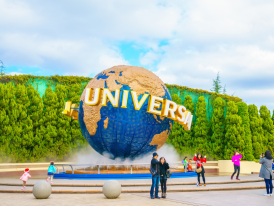
Kids playing near Universal Studios Osaka
Osaka Bay Area: Big Attractions & Wide-Open Stays
Osaka Bay offers space and modern amenities that downtown areas can't match. The apartment hotel options here provide more room for families or extended stays, while the location gives easy access to Universal Studios and the aquarium. Many properties offer family rooms and convenient locations for travelers with children. But this convenience comes with isolation, you'll depend on trains for most dining options and local attractions beyond the immediate bay area.
I recommend the bay area for specific trip types: families with young children who need space and early bedtimes, Universal Studios enthusiasts who want to maximize park time, or business travelers attending events at the convention centers. The area works less well for food-focused trips or spontaneous neighborhood exploration.
Universal Studios dominates the bay's western section, creating a bubble of themed entertainment that feels disconnected from broader Osaka culture. The park delivers polished experiences that justify admission costs, but surrounding hotels and restaurants cater to this captive audience with pricing that reflects limited competition.
Transportation from the bay requires planning. JR trains connect to downtown efficiently during peak hours, but service becomes less frequent in the evenings. The last trains leave earlier than from central neighborhoods, which limits your options for late-night activities. Budget extra time and money for taxi rides if you plan to stay out late.
The bay's eastern sections offer quieter atmosphere alternatives with harbor views and modern apartment hotel accommodations. These hotels attract business travelers and families who prioritize spacious rooms over location. Dining options remain limited, but several hotels provide kitchenettes that let you supplement restaurant meals with grocery purchases. The area lacks the food stalls and street food culture of central neighborhoods, but it compensates with modern rooms and family-friendly amenities.
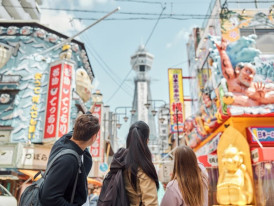
Tsutenkaku Tower against early morning sky.
Tennoji & Abeno: Honest Osaka With a View
Tennoji and Abeno represent Osaka without the tourist polish; working neighborhoods where people live, work, and eat without performing for visitors. The area combines affordable accommodations with genuine local character, though you'll sacrifice some convenience compared to central locations. These are some of the best secret places in Osaka.
The iconic Tsutenkaku Tower anchors this district's identity, but the surrounding Shinsekai area offers more complex experiences than its retro reputation suggests. Kushikatsu restaurants cluster here in concentration that creates genuine competition for quality. I eat in Shinsekai when I want examples of Osaka comfort food prepared by cooks who serve local customers daily rather than tour groups occasionally.
Japan's tallest building is in Abeno Harukas, it displays impressive rooftop observation deck views. Unlike tourist-focused observation platforms elsewhere, this one serves primarily local visitors, creating a quieter atmosphere for taking in Osaka's full scope. The building also houses quality department store dining that offers alternatives to street food without tourist markup. The Abeno Harukas Art Museum regularly features international art exhibitions that provide cultural experiences beyond the typical sightseeing circuit.
Hotels in Tennoji range from basic business properties to recently renovated mid-range options. The area's improving reputation has attracted investment in stylish hotels that offer modern amenities at more affordable prices than downtown equivalents. Subway station connections work well for reaching other neighborhoods, though you'll need transfers for some destinations. The convenient location provides easy access to both city center attractions and local residential area experiences.
The district's authenticity includes elements that some travelers find challenging. Streets show more wear than polished tourist zones, and English signage appears less frequently. But these characteristics also mean lower prices, fewer crowds, and interactions that feel less transactional than in heavily visited areas.
What if your day in Osaka was planned by someone who knows it — and you?
City Unscripted matches you with a local host who creates a private experience based on your interests, not a set route.
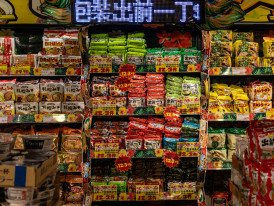
Retro market stall selling local snacks Photo by Bernd
Hidden Neighborhoods Worth Your Time
Beyond the famous districts, Osaka hides neighborhoods that reveal different aspects of city life. These areas work better for day visits than hotel bases, but they offer experiences that contrast sharply with tourist-focused zones.
Noda, northwest of central Osaka, maintains a residential character that includes specialty coffee shops, small restaurants, and local shopping streets unchanged by tourism pressure. I visit Noda when I want to see how Osaka residents live without the amplified energy of entertainment districts.
Sumiyoshi and Nippombashi offer different perspectives on traditional and modern Osaka culture. Sumiyoshi combines residential areas with shrine grounds that host local festivals throughout the year. Nippombashi mixes electronics shopping with emerging food scenes that attract young Osakans looking for alternatives to established districts.
These neighborhoods require more effort to navigate but reward curiosity with more affordable prices and more authentic interactions. Local culture appears in daily rhythms rather than tourist presentations, creating opportunities to understand how contemporary Osaka functions beyond its marketed image. Art galleries and small cultural venues scattered through these areas showcase local creativity without the international art focus of major museums.
Choosing Based on Your Travel Style
When deciding among the best neighborhoods to stay in Osaka, your travel style should guide your choice more than generic recommendations. Each area serves different priorities, and understanding these distinctions helps you avoid common booking mistakes.
Budget-conscious travelers should focus on Tennoji, Nippombashi, or neighborhoods slightly outside central areas where budget hotels offer better value and subway access remains reliable. These areas require longer commutes to famous attractions but provide more money for experiences rather than accommodation.
Luxury seekers find their best options in Umeda's business district or select properties in Namba that charge premium rates for prime locations. Five star hotels concentrate in these areas, offering international standards and concierge services that can arrange Osaka experiences tailored to high-end preferences.
Food enthusiasts should prioritize neighborhoods with diverse dining options within walking distance. Namba and Shinsaibashi excel for street food and late-night options, while Tennoji offers authentic local cuisine without tourist inflation. Umeda provides convenience but less culinary adventure.
Families need space, safety, and easy access to attractions that engage children. Osaka Bay's apartment hotels serve these requirements well, though isolation limits dining flexibility. Umeda offers family-friendly hotels with modern amenities, while Namba provides excitement that may overwhelm young travelers.
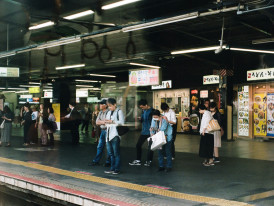
Busy platform at Namba Station during rush hour Photo by Frederica Diamanta on Unsplash
Transportation: The Hidden Factor in Neighborhood Choice
Subway station proximity affects your daily experience more than hotel amenities or neighborhood character. Osaka's train system operates efficiently, but walking distances, transfer requirements, and service frequency vary significantly between areas.
Osaka Station and Namba Station provide the most comprehensive access to other neighborhoods and attractions. Hotels within 5-10 minutes' walk of these hubs save time and energy throughout your trip. Shinsaibashi Station offers good connectivity with less crowding than major terminal stations.
Areas requiring transfers to reach major attractions become expensive and time-consuming. I calculate transportation costs and travel time when comparing hotel prices, as central locations often provide better value despite higher nightly rates.
Evening transportation schedules affect neighborhood choice for travelers who want active nightlife. Central areas maintain frequent service later, while outlying areas may require expensive taxi rides after midnight. Check last train times for your planned activities before booking accommodations.
Tip
We match you with the right host, not just any guide.Want to experience the real Osaka with someone who lives there?
A fully private experience, planned and led by a local host who tailors the day to you
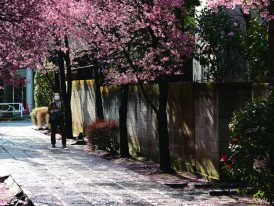
Cherry blossoms lining a quiet street in Sumiyoshi Photo by wayne shang on Unsplash
Seasonal Considerations for Neighborhood Selection
Osaka's seasons affect neighborhood comfort and accessibility. Summer heat makes subway proximity essential, as walking becomes uncomfortable during afternoon hours. Hotels with good air conditioning become priorities over scenic locations or budget savings.
Cherry blossom season transforms certain areas into major tourist destinations with corresponding price increases and crowd challenges. Hotels in Namba and around Osaka Castle experience peak demand during spring, while areas like Tennoji remain more accessible.
Winter weather makes underground connections valuable. Umeda's extensive underground network provides comfort during cold months, while areas requiring outdoor walking between stations become less appealing for extended sightseeing.
Rainy season affects different neighborhoods based on drainage and covered walkways. Areas with extensive arcades and underground passages maintain appeal during wet weather, while outdoor markets and street food scenes become less accessible.
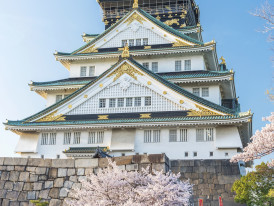
Families visiting Osaka Castle during cherry blossom season
Essential Local Attractions Beyond the Famous Sites
While everyone knows about Osaka Castle and Universal Studios, the city's neighborhoods harbor local attractions that provide different perspectives on regional culture. The Osaka Science Museum in Umeda offers interactive exhibits that engage visitors of all ages, while maintaining the quieter atmosphere that many families prefer over crowded tourist sites.
Tennoji Zoo might not match the scale of other Japanese zoos, but it provides authentic local experiences where families can observe how Osakans spend leisure time. The surrounding Tennoji Park extends these opportunities with seasonal events and festivals that reveal community traditions rarely seen by visitors focused solely on major attractions.
Art galleries throughout various neighborhoods showcase contemporary Japanese creativity alongside international art exhibitions. Unlike the major museums that cater to tour groups, these smaller venues provide intimate settings where you can appreciate both local and global artistic perspectives. Many offer rotating exhibitions that change throughout the year, giving repeat visitors new experiences.
Making Your Final Decision
The best neighborhood for your Osaka stay balances your priorities against realistic constraints. Consider your non-negotiable requirements first: budget range, group size, must-see local attractions, and preferred activity schedule. Then evaluate neighborhoods based on how well they support these priorities while offering the convenient location access you need.
Most visitors benefit from staying in central areas (Namba, Shinsaibashi, or Umeda) for their first trip to explore Osaka. These locations provide easy access to major attractions while offering diverse dining options and transportation connections that accommodate various daily plans. Popular hotels in these areas typically offer modern amenities, though you'll pay premium rates for the convenient location.
Return visitors or travelers with specific interests might prefer focused neighborhood choices. Food lovers could base themselves in Tennoji for authentic local cuisine and street food stalls, while luxury travelers might prioritize Umeda's premium hotels like the Ritz Carlton with modern rooms, fitness centers, and business district amenities. Families often benefit from apartment hotel options that provide family rooms and spacious accommodations.
Remember that perfect neighborhoods don't exist, every area involves tradeoffs. The goal is choosing tradeoffs that align with your travel style and priorities rather than chasing idealized versions of Osaka that exist more in marketing materials than daily reality. Whether you prioritize nightlife hotspots or a quieter atmosphere, modern amenities or more affordable prices, understanding these tradeoffs helps you make informed decisions about your hotel stay.
Ready to plan your perfect day in Osaka?
Start your experience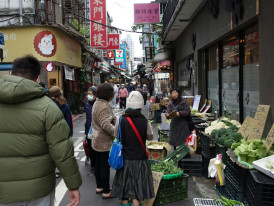
Local residents shopping at morning market near Sumiyoshi Photo by MChe Lee on Unsplash
Beyond the Hotel: Living Like a Local
Regardless of where you stay in Osaka, the real experiences happen when you adopt local rhythms rather than tourist schedules. Shop at morning markets, eat lunch at places without English menus, take evening walks through residential areas, and use public transportation during off-peak hours. Many Osaka hotels provide complimentary coffee in the morning, use this time to plan your day's exploration of local life.
Each neighborhood rewards different types of exploration. Umeda's underground maze becomes fascinating when you're not rushing to catch trains, and you'll discover that it's more complex than Paris's underground network—though certainly not as romantically designed as the area around the Eiffel Tower. Namba's side streets reveal specialty shops that escape guidebook attention, while the Minami area's back alleys hide local dining gems. Tennoji's working-class character provides context for understanding contemporary Japanese urban life in residential areas where tourists rarely venture.
The key is spending time in your chosen neighborhood rather than just sleeping there. Walk the local shopping streets, identify the popular lunch spots, notice the daily patterns of residents. This approach transforms any area into a more meaningful base for your Osaka exploration.
Your neighborhood choice shapes your trip's character, but your curiosity and attention to local details determine whether you experience authentic Osaka culture or just its tourist-friendly surface. Choose thoughtfully, then explore deeply.
For more authentic local experiences beyond the typical tourist trail, explore our curated Osaka experiences that connect you with the city's genuine character and local culture.
What if your day in Osaka was planned by someone who knows it — and you?
City Unscripted matches you with a local host who creates a private experience based on your interests, not a set route.
Want to experience the real Osaka with someone who lives there?
A fully private experience, planned and led by a local host who tailors the day to you









